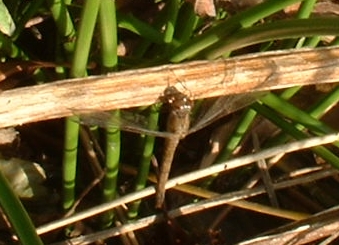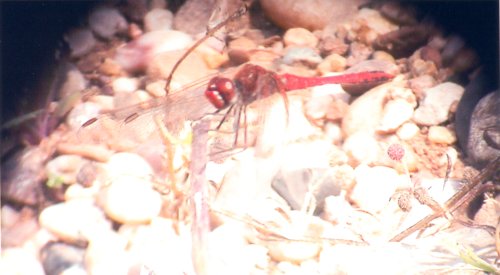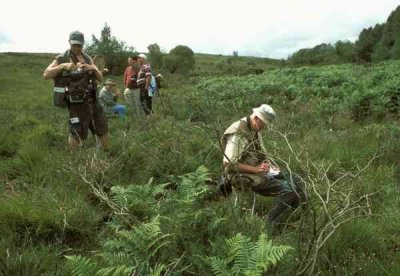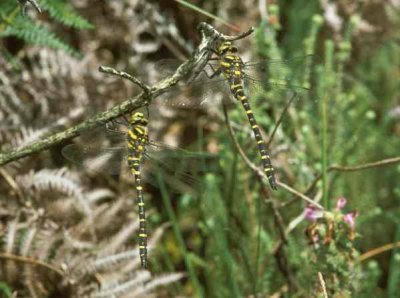|
||||||||||||||||||||||||||||||||||||||||||||||||||||||||||||||||||||||||||||||||||||||||||||||||||||||||||||||||||||||||||||||||||
Warwickshire Dragonfly Group - News page14th December Late flying dragonflies of 2006 Table of Earliest Dates for 2006 August 28th 2006 More on Small Red-eyed Damselfly sightings
August 14th 2006 Small Red-eyes and Red-veined Darters July 30th 2006 Thelsford Farm meeting July 8th 2006 Catherton Common meeting
June 4th 2006 Scarce Blue-tail, Emperor and Common Darter flying June 3rd 2006 Black-tailed Skimmer and Common Blue Damselfly - at last - plus ID Workshop May 25th
2006
Club-tailed Dragonfly and White-legged Damselfly at Marlcliff May 16th
2006
First Four-spot, Broad-bodied, Hairy and Red-eye of 2006? March 23rd 2006
Indoor meeting report. Steve
Cham's fantastic presentation! Table of
November flying dragonflies The first Warwickshire November records are from Nick Barlow so he starts the late list. Some late records from Jonathan Bowley are: Southern Hawker and Ruddy Darter at Wormleighton Reservoir, October 21st and Migrant Hawker on Oxford Canal, Fenny Compton, October 31st (both sightings just outside the November window for the table) plus November sightings of Common Darter, see the table. We were surprise to see a male Southern Hawker at Sourland Pool, Farnborough on 9th November. It was a sunny but quite cool day but the Hawker was actively seeking females at the water's edge. The previous latest date in the Darter database for Warwickshire is October 28th 1995. No other odonates were seen there. More late flights. Paul Hodges spotted a Common Darter at Coombe Abbey and Jonathan Bowley spotted a Migrant Hawker at Wormleighton Reservoir, both on 12th November. Glyn Clarke reports several November sighting. From his mail: Cryfield
Grange Pool, 4/11/06
The last two dates are the latest I have for any flying dragonfly in
Warwickshire and comfortably break Glyn's 2005 record of 16th November
for Common Darter.Common Darter - 9, including 2 ovipositing pairs. Cryfield Grange Pool, 19/11/06 Common Darter - in sunshine at 12-30 a female was watched in the centre of a pigmyweed-infested small pool. After a spell of wing-whirring she took off and spent a couple of minutes ovipositing, flying about quite actively & then disappeared into cover. Reappearing 10 minutes later there was a bit more ovipositing behaviour then disappearance again. No male was seen during these periods. Later a male was seen briefly flying at waters-edge. Possibly a second male flew strongly about 50 metres over rough ground nearby No activity seen after 1-15pm. Cryfield Grange Pool 20/11/06 Paid a brief visit there today and at 12-30 there was a male Common Darter sunbathing on a south-facing concrete block on the edge of the small feeder pool, which then flew into cover. Another mail, complete with photos, from Glyn Clarke was sent to me on the 27th November (but not received until 13th December due to problems with spam overloading the mail server at my ISP):
We have probably seen the last of this year's fliers but if you have a November (or even December!) date please let me know.
Back to page top. Table of Earliest Dates Recorded We now have dates of all breeding Warwickshire species for 2006. If you have any earlier dates for 2006 or historic dates please let me have them.
This year's dates for most species are significantly later than the
earliest recorded for previous years. However, Broad-bodied Chaser is
about "on
time" or even earlier than historically if the possible sighting at
Brandon Marsh on 26th April is taken into account. For the Emperor Dragonfly we have the earliest recorded date for the
county. A complete contrast to other sightings this year. Here is a
"theory". The Emperors are large powerful fliers. Could this one be an
immigrant from the warmer South? Our new species, the Small Red-eyed Damselfly, is significantly
earlier. This may be because it is now breeding in the county not
flying in from elsewhere. I have composed a Red-eye identification web page, follow link: http://www.reeve60.uklinux.net/wdg/SRED_id.php Back to page top. The peak of the flight period for most dragonfly species is coming
to an end. But there should still be plenty of Migrant Hawkers and Common Darters for a while
yet. Also, the Small
Red-eyed Damselflies should be flying in numbers and so they are
worth watching out
for. They have been found at three more sites in the county and are in
very
good numbers where they were seen last year.
Marsh Lane Reserve, Hampton-in-Arden is still our furthest
north-westerly location.
The Group field meetings are
now over for this year. Reports for the Catherton Common and Thelsford
Farm meetings are presented below.
Overnight rain brought an end to the July hot spell
and
the temperature dropped from the high twenties of the previous few
days to reach a maximum of twenty-two. The day was made more
comfortable by a fresh westerly breeze. How would the dragonflies
react to this sudden change in the weather? We arrived at the main pool, 30 by 300 metres in
extent,
at 10.30 flushing a solitary Black-tailed Skimmer on the way there.
It was fairly cloudy and there was little activity on the water. Only
a few Common Blue and Common Blue-tailed Damselflies were to be seen.
After more careful scanning of the floating vegetation a male
Red-eyed Damselfly was spotted. It was not a Small Red-eye. The sun
came out and activity increased. More Common Blues and more
Blue-tails appeared and, quite well out into the pool, another male
Red-eye. Through binoculars it appeared the abdomen was curving up in
a significant way. A telescope showed that it was a Small Red-eyed
Damselfly. It was the first record for the species on this site, some
20 km from the nearest known location for the species. After watching
it for some while we became aware of several other males and then a
tandem pair flew into view. The female set about ovipositing. The
telescope was brought to bear again and we were able to watch the
female disappear below the surface until just the tips of her wings
were visible. For some of our group this was their first sight of
Small Red-eyed Damselfly. Ten to fifteen males were present and a
second ovipositing pair was seen. It was now sunnier and warmer and more activity was
apparent but it was still somewhat subdued. A few each of Emerald
Damselfly, Black-tailed Skimmer and Common Darter, a single Brown
Hawker and a single Ruddy Darter but no Emperors were seen. All are
well known at this site and some are prolific.
A walk to the River Avon, about a half a mile across the
meadows, yielded feeding Brown Hawkers and an Emperor Dragonfly. At
the river were Banded Demoiselles and White-legged Damselflies though
neither species was seen in great numbers. We were also surprised to
find several Brown Hawkers ovipositing in the bank side vegetation
and wet mud and two pairs of Ruddy Darter, one pair mating the other
pair ovipositing. None of this activity was seen at the pool.
After lunch a second pool was visited and , again, it
was quiet and yielded nothing new. However, there were about a dozen
Brown and two or three Migrant Hawkers feeding over the crop in the
adjacent field. A female Migrant Hawker perched conveniently and
patiently providing the photographers with a good subject.
It did appear the change in the weather had affected the
numbers and activity of the dragonflies. Also, some species we
expected to see were absent. However, thirteen species were recorded
on the day and we had the extra thrill of the first record of Small
Red-eyed Damselfly at Thelsford. Finally, a thank you to Mrs Jennifer Meir for permission to visit the site. Report
on field meeting at Catherton Common, Shropshire, 8th July 2006
Glyn Clarke sent me his records for the last couple of days just too
late for me to include in the report for 3rd June. As usual with Glyn
he has interesting sighting to report. Scarce Blue-tailed
Damselflies are
out at our only Warwickshire site, about 20 individuals counted
including a mating pair. This population is still strong. Glyn
also found a teneral Common
Darter and Emperor Dragonfly in flight. This Emperor
record is the earliest we have so far for Warwickshire, a contrast to
all the other first records we have this year - see my "theory" in the Earliest Dates above. The late arrival of records (and presumably the emergence) of adults continues. Common Blue Damselfly is very late; we saw our first at Packington Park of 31st May. Two days later, on the 2nd June, with the weather much warmer our first newly emerged Black-tailed Skimmer was spotted at Marsh Lane Reserve, Hampton in Arden. Sixteen attended the Group ID Workshop at Brandon Marsh Nature
Centre on Saturday 3rd June. The weather was even warmer than the
previous day and so we were all pleased when the indoor session was
over and we could get outside. All the species that might be expected
at Brandon this time of the year were found but numbers were not large
and many individuals had only recently emerged. This was particularly
true of the Dragonflies. Even so, Four-spotted Chaser males were
holding territory on Goose Pool and on the Carlton Hide pool. Species
seen were: Banded Demoiselle, Large Red, Azure, Common Blue and
Red-eyed Damselflies, Four-spotted and Broad-bodied Chasers and
Black-tailed Skimmer. We also enjoyed some good views of a Hobby. A visit to the Avon at Marlcliff (SP093506) by Kay and Peter
produced our first Club-tailed
Dragonflies and White-legged
Damselflies of 2006. Between three and five adults, both
males and females, were about. In addition we observed the maiden
flight of a female Club-tailed - just within Warwickshire - confirming
of breeding in the county for 2006. There were large numbers of
White-legged Damselflies present all immature and many making maiden
flights. Banded
Demoiselles were present in profusion. Some were mature, or almost
so, and looking for territories. Others were making maiden flights.
Further upstream at Welford on Avon we were unable to find the
Club-tailed but both White-legged and Banded Demoiselle were there in
good numbers. May 16th 2006 Around twenty-five of us met at the Brandon Marsh Nature Centre for our traditional annual indoor meeting. After a brief review of our 2005 activities and a plea for dragonfly records for Warwickshire both for the past and 2006 we got on to the main event of the evening - Steve Cham's presentation. What a treat this was! As usual Steve impressed us all by his wide and deep knowledge of dragonflies and their behaviour. His talk was supported by some truly amazing photographs of dragonflies in flight, even including moving pictures! His description of the comparative behaviour of (Large) and Small Red-eyed Damselflies was fascinating and demonstrated what patient observation can reveal. How does he manage to do so much? Authoring books and producing them, managing the National Dragonfly database, recording dragonflies in Bedfordshire, closely observing dragonfly behaviour and producing remarkable photographs of them. And he still finds time to come and talk to groups of enthusiasts like us. Very many thanks to you, Steve, for a memorable evening. Also, many thanks to the Warwickshire Wildlife Trust and staff for allowing us the use of the Barn at the Nature Centre.
Peter Reeve, Co-ordinator WDG
|

 The migrant highlight this year, so far, was the
sightings of
The migrant highlight this year, so far, was the
sightings of 
